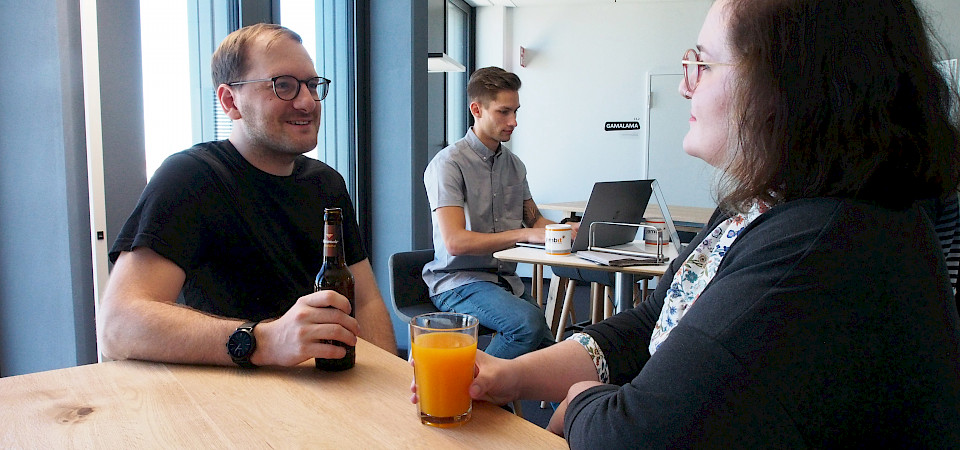
How and when do people use an app? How do people behave in their workplace and how do technological solutions support individual work habits? User studies in software development can help with these questions.
At jambit, UX experts deal with the implementation of user studies. Together with Fujitsu Technology, jambit recently developed an app that connects various devices such as standing desks and lamps with a mobile device and allows individual profiles.
In addition to software development, we took advantage of user studies. In our user-centered design division, designers, psychologists, and developers work on making applications more intuitive and reducing development costs with an empirically based and focused use of resources.
How do user studies support software development projects?
User studies are used for quality management during software development. For example, to design the app interface optimally for the user and to effectively solve the work task to the utmost satisfaction. At the same time, user studies with users can contribute to finding ideas for features and needs.
This is important, for example, to not miss the user's needs in development and to make a real contribution in product development. Products are often initiated by stakeholders who are pursuing very specific strategic reasons, such as economic ones.
This can lead to discrepancies between the expectations of users or customers and the ideas of manufacturers. Companies avoid such trade-offs with purposive user studies. They integrate the user into the value creation process at an early stage.
How do the different approaches to UX evaluation differ?

During the development phases, UX experts distinguish between formative and summative approaches. Formative evaluations are used in an iterative process to identify improvements prior to development.
Summative evaluations are used to assess a shipped product compared to other products, such as a benchmark. Formative evaluations focus on determining which aspects of the design work well or not and why. These evaluations take place during redesign and provide information to incrementally improve the user interface.
How do clients benefit from UX departments?
Efficiency in development, the product's fit with the target group, and future product marketing can benefit from UX methods right from the start. The key factor is that service providers have both the methodological background of analysis and agile project management as well as operational competences in software development and design implementation.
How does a user study with jambit work?
At the beginning, UX teams define the goal of the user study together with the customer. Formulating the goal or question is needed first to define the methodology and the structure of the research project. For a project, a product can be examined according to aesthetic or emotional principles, for example.
At the same time, however, products can also be examined with regard to their usability to improve their efficiency. UX experts work out the research question together with the client and make recommendations on the research design and sample selection, such as the number of test subjects. Where simple usability tests require a smaller number of study participants, studies on safety-relevant aspects require a larger number of participants.
Cultural aspects must also be taken into account. Feedback is expressed differently in different cultures and can influence the results. To gain knowledge, hypotheses must be formulated to verify or falsify them in a second step.
There is a spectrum of methods in UX research and a selection can be found here:
Usability Walkthrough
In a usability walkthrough, a trained expert guides the user through the project with a prototype or a click dummy and comments on their actions during the walkthrough.
Contextual Inquiry
Contextual inquiry is used to gain an overview of the relevant work environment, the communication, and the overall context. Through observation and collaborative interpretation, contextual inquiry uncovers hidden insights into the customer's work. This provides a detailed picture of processes. For example, a user is observed in their usual work environment and then asked about actions and motivations.
User Interviews
Interviews can provide information about users' personal impressions and highlight aspects with particular research interest by asking specific questions.
Quantiative Studies
Quantitative studies, such as the "usability test", can support hypotheses with representative data sets and decisions in UX planning. In a usability test, tasks are examined under laboratory conditions. The user performs standardized tasks and the progress is documented quantitatively, for example, via the number of clicks. To achieve representative results, a larger number of test subjects is required than in the qualitative methods mentioned above.
How to use the results in the project?

At jambit, we hold a workshop after the project to create an overview of the results or data. In this workshop, we present and cluster all results and clearly document them as recommendations for action.
As a software service provider, we bring together not only UX research specialists and designers, but also software architects. Interdisciplinary teams pay off when UX requirements and software technical aspects such as performance have to be interlocked and tested hand in hand later on.
What is important to consult in UX research?
To advise clients holistically in the area of user-centered design, you need a scientific background in a relevant subject or at least a great enthusiasm and discipline to familiarize yourself with empirical methods and software ergonomics. Degree programs in human-machine interaction or human factors engineering offer training in this field. Interdisciplinary teams need to have scientific know-how in user studies but also operational implementation competence in design to effectively accompany projects. jambit's user-centered design divison brings both aspects to software projects in our various industries.


